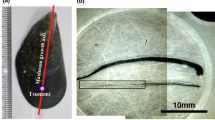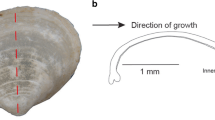Abstract
Barium/calcium profiles of bivalve shells are characterized by flat background signals periodically interrupted by sharp peaks, with the background signals correlated with water Ba/Ca. To test if the peaks are an environmental signal related to productivity, we analyzed high-resolution Ba/Ca profiles in bivalve shells that grew adjacent to one another. Two aragonitic Saxidomus giganteus show remarkable similarity over a decade of growth, clearly indicating an environmental forcing. Four calcitic Pecten maximus shells also record synchronous Ba/Ca peaks, again indicating an exogenous control. The Ba/Ca peaks, however, start ~40 days after the crash of a bloom, while sedimentation takes place immediately following the bloom. Barite formation in settling phytoplankton flocs, as has been previously proposed, is clearly not the cause of these peaks. Other possible causes, such as dissolved Ba in ambient water, spawning, shell organic matter content, and kinetic growth rate effects are also discussed, but none provide satisfactory explanations. Background shell Ba partition coefficients (Ba/Cacarbonate/Ba/Cawater) for both the calcitic shells (0.18) and aragonitic shells (0.16) are similar to that previously reported for the calcitic Mytilus edulis (~0.1). We suggest that Ba/Ca peaks in bivalve shells are caused by an as yet undetermined environmental forcing, while background Ba/Ca levels are a good indication of dissolved Ba/Ca in the water; both are independent of shell mineralogy.
Similar content being viewed by others
References
Bishop JKB (1988) The barite–opal–organic carbon association in oceanic particulate matter. Nature 332:341–343
Böhm F, Joachimski MM, Dullo WC, Eisenhauer A, Lehnert H, Reitner J, Worheide G (2000) Oxygen isotope fractionation in marine aragonite of coralline sponges. Geochim Cosmochim Acta 64:1695–1703
Carré M, Bentaleb I, Bruguier O, Ordinola E, Fontugne M (2006) Calcification rate influence on trace elements incorporation in marine bivalve aragonite: evidences and mechanisms. Geochim Cosmochim Acta 70:4906–4920
Chauvaud L, Thouzeau G, Paulet Y-M (1998) Effects of environmental factors on the daily growth rate of Pecten maximus juveniles in the Bay of Brest (France). J Exp Mar Biol Ecol 227:83–111
Chauvaud L, Lorrain A, Dunbar RB, Paulet Y-M, Thouzeau G, Jean F, Guarini J-M, Mucciarone D (2005) The shell of the great scallop Pecten maximus as a high frequency archive of paleoenvironmental change. Geochem Geophys Geosyst 6:Q08001. doi:10.1029/2004GC000890
Coffey M, Dehairs F, Collette O, Luther G, Church T, Jickells T (1997) The behaviour of dissolved barium in estuaries. Estuar Coast Shelf Sci 45:113–121
Dehairs F, Chesselet R, Jedwab J (1980) Discrete suspended particles of barite and the barium cycle in the open ocean. Earth Planet Sci Lett 49:528–550
De Ridder F, Pintelon R, Schoukens J, Gillikin DP, André L, Baeyens W, de Brauwere A, Dehairs F (2004) Decoding nonlinear growth rates in biogenic environmental archives. Geochem Geophys Geosyst 5:Q12015. doi:10.1029/2004GC000771
Dietzel MN, Gussone N, Eisenhauer A (2004) Co-precipitation of Sr2+ and Ba2+ with aragonite by membrane diffusion of CO2 between 10 and 50 degrees C. Chem Geol 203:139–151
Freitas PS, Clarke LJ, Kennedy H, Richardson CA, Abrantes F (2006) Environmental and biological controls on elemental (Mg/Ca, Sr/Ca and Mn/Ca) ratios in shells of the king scallop Pecten maximus. Geochim Cosmochim Acta 70:5119–5133
Fritz LW, Ragone LM, Lutz RA (1990) Biomineralization of barite in the shell of the freshwater Asiatic clam Corbicula fluminea (Mollusca: Bivalvia). Limnol Oceanogr 35:756–762
Gaetani GA, Cohen AL (2006) Element partitioning during precipitation of aragonite from seawater: a framework for understanding paleoproxies. Geochim Cosmochim Acta 70:4617–4634
Ganeshram RS, Francois R, Commeau J, Brown-Leger SL (2003) An experimental investigation of barite formation in seawater. Geochim Cosmochim Acta 67:2599–2605
Gillikin DP (2005) Geochemistry of marine bivalve shells: the potential for paleoenvironmental reconstruction. PhD Thesis, Vrije Universiteit Brussel, Belgium
Gillikin DP, Lorrain A, Navez J, Taylor JW, André L, Keppens E, Baeyens W, Dehairs F (2005a) Strong biological controls on Sr/Ca ratios in aragonitic marine bivalve shells. Geochem Geophys Geosyst 6:Q05009. doi:10.1029/2004GC000874
Gillikin DP, De Ridder F, Ulens H, Elskens M, Keppens E, Baeyens W, Dehairs F (2005b) Assessing the reproducibility and reliability of estuarine bivalve shells (Saxidomus giganteus) for sea surface temperature reconstruction: implications for paleoclimate studies. Palaeogeogr Palaeoclimatol Palaeoecol 228:70–85
Gillikin DP, Dehairs F, Lorrain A, Steenmans D, Baeyens W, André L (2006) Barium uptake into the shells of the common mussel (Mytilus edulis) and the potential for estuarine paleo-chemistry reconstruction. Geochim Cosmochim Acta 70:395–407
Hart SR, Cohen AL, Ramsay P (1997) Microscale analysis of Sr/Ca and Ba/Ca in Porites. In: Proc 8th Int Coral Reef Symp 2:1707–1712
Kingston AW, Gröcke DR, Burchell M (2008) A multiaxial growth analysis of stable isotopes in the modern shell of Saxidomus gigantea: implications for sclerochronology studies. Geochem Geophys Geosyst 9:Q01007. doi:10.1029/2007GC001807
Lazareth CE, Vander Putten E, André L, Dehairs F (2003) High-resolution trace element profiles in shells of the mangrove bivalve Isognomon ephippium: a record of environmental spatio-temporal variations? Estuar Coast Shelf Sci 57:1103–1114
Lea DW (2003) Elemental and isotopic proxies of marine temperatures. In: Elderfield H (ed) The oceans and marine geochemistry. Elsevier-Pergamon, Oxford, pp 365–390
Lea DW, Shen GT, Boyle EA (1989) Coralline barium records temporal variability in equatorial Pacific upwelling. Nature 340:373–376
Lorrain A, Paulet Y-M, Chauvaud L, Savoye N, Nézan E, Guérin L (2000) Growth anomalies in Pecten maximus from coastal waters (Bay of Brest: France): relationship with diatom blooms. J Mar Biol Assoc UK 80:667–673
Lorrain A, Paulet Y-M, Chauvaud L, Dunbar R, Mucciarone D, Fontugne M (2004) δ13C variation in scallop shells: increasing metabolic carbon contribution with body size? Geochim Cosmochim Acta 68:3509–3519
Lorrain A, Gillikin DP, Paulet Y-M, Chauvaud L, Le Mercier A, Navez J, André L (2005) Strong kinetic effects on Sr/Ca ratios in the calcitic bivalve Pecten maximus. Geology 33:965–968
McCulloch MT, Fallon S, Wyndham T, Hendy E, Lough J, Barnes D (2003) Coral record of increased sediment flux to the inner Great Barrier Reef since European settlement. Nature 421:727–730
Mucci A, Morse JW (1990) Chemistry of low-temperature abiotic calcites: experimental studies on coprecipitation, stability and fractionation. Rev Aquat Sci 3:217–254
Paulet Y-M, Fifas S (1989) Potential fecundity of the scallop, Pecten maximus, from the bay of Saint-Brieuc. Haliotis 19:275–285
Paulet Y-M, Dorange G, Cochard JC, Le Pennec M (1992) Reproduction and recruitment in Pecten maximus L. Ann Inst Océanogr Paris 681:45–64
Paulet Y-M, Bekhadra F, Dechauvelle N, Donval A, Dorange G (1997) Seasonal cycles, reproduction and oocyte quality in Pecten maximus from the Bay of Brest. Ann Inst Océanogr Paris 73:101–112
Pearce NJG, Perkins WT, Westgate JA, Gorton MP, Jackson SE, Neal CR, Chenery SP (1997) A compilation of new and published major and trace element data for NIST SRM 610 and NIST SRM 612 glass reference materials. Geostand Newslett 21:115–144
Purton LMA, Shields GA, Brasier MD, Grime GW (1999) Metabolism controls Sr/Ca ratios in fossil aragonitic mollusks. Geology 27:1083–1086
Rosenberg GD, Hughes WW, Parker DL, Ray BD (2001) The geometry of bivalve shell chemistry and mantle metabolism. Am Malacol Bull 16:251–261
Rosenheim BE, Swart PK, Thorrold SR (2005) Minor and trace elements in sclerosponge Ceratoporella nicholsoni: biogenic aragonite near the inorganic endmember? Palaeogeogr Palaeoclimatol Palaeoecol 228:109–129
Rosenthal Y, Katz A (1989) The applicability of trace elements in freshwater shells for paleogeochemical studies. Chem Geol 78:65–76
Sinclair DJ (2005) Non river-flood barium signals in the skeletons of corals from coastal Queensland, Australia. Earth Planet Sci Lett 237:354–369
Sinclair DJ, McCulloch MT (2004) Corals record low mobile barium concentrations in the Burdekin River during the 1974 flood: evidence for limited Ba supply to rivers? Palaeogeogr Palaeoclimatol Palaeoecol 214:155–174
Stecher HA, Kogut MB (1999) Rapid barium removal in the Delaware estuary. Geochim Cosmochim Acta 63:1003–1012
Stecher HA, Krantz DE, Lord CJ, Luther GW, Bock KW (1996) Profiles of strontium and barium in Mercenaria mercenaria and Spisula solidissima shells. Geochim Cosmochim Acta 60:3445–3456
Surge D, Walker KJ (2006) Geochemical variation in microstructural shell layers of the southern quahog (Mercenaria campechiensis): implications for reconstructing seasonality. Palaeogeogr Palaeoclimatol Palaeoecol 237:182–190
Takesue RK, van Geen A (2004) Mg/Ca, Sr/Ca, and stable isotopes in modern and Holocene Protothaca staminea shells from a northern California coastal upwelling region. Geochim Cosmochim Acta 68:3845–3861
Tesoriero AJ, Pankow JF (1996) Solid solution partitioning of Sr2+, Ba2+, and Cd2+ to calcite. Geochim Cosmochim Acta 60:1053–1063
Vander Putten E, Dehairs F, Keppens E, Baeyens W (2000) High resolution distribution of trace elements in the calcite shell layer of modern Mytilus edulis: environmental and biological controls. Geochim Cosmochim Acta 64:997–1011
Walter E, Pronzato L (1994) Identification de modèles paramétriques à partir de données expérimentales. Masson, Paris
Zacherl DC, Paradis G, Lea DW (2003) Barium and strontium uptake into larval protoconchs and statoliths of the marine neogastropod Kelletia kelledi. Geochim Cosmochim Acta 67:4091–4099
Author information
Authors and Affiliations
Corresponding author
Rights and permissions
About this article
Cite this article
Gillikin, D.P., Lorrain, A., Paulet, YM. et al. Synchronous barium peaks in high-resolution profiles of calcite and aragonite marine bivalve shells. Geo-Mar Lett 28, 351–358 (2008). https://doi.org/10.1007/s00367-008-0111-9
Received:
Accepted:
Published:
Issue Date:
DOI: https://doi.org/10.1007/s00367-008-0111-9




